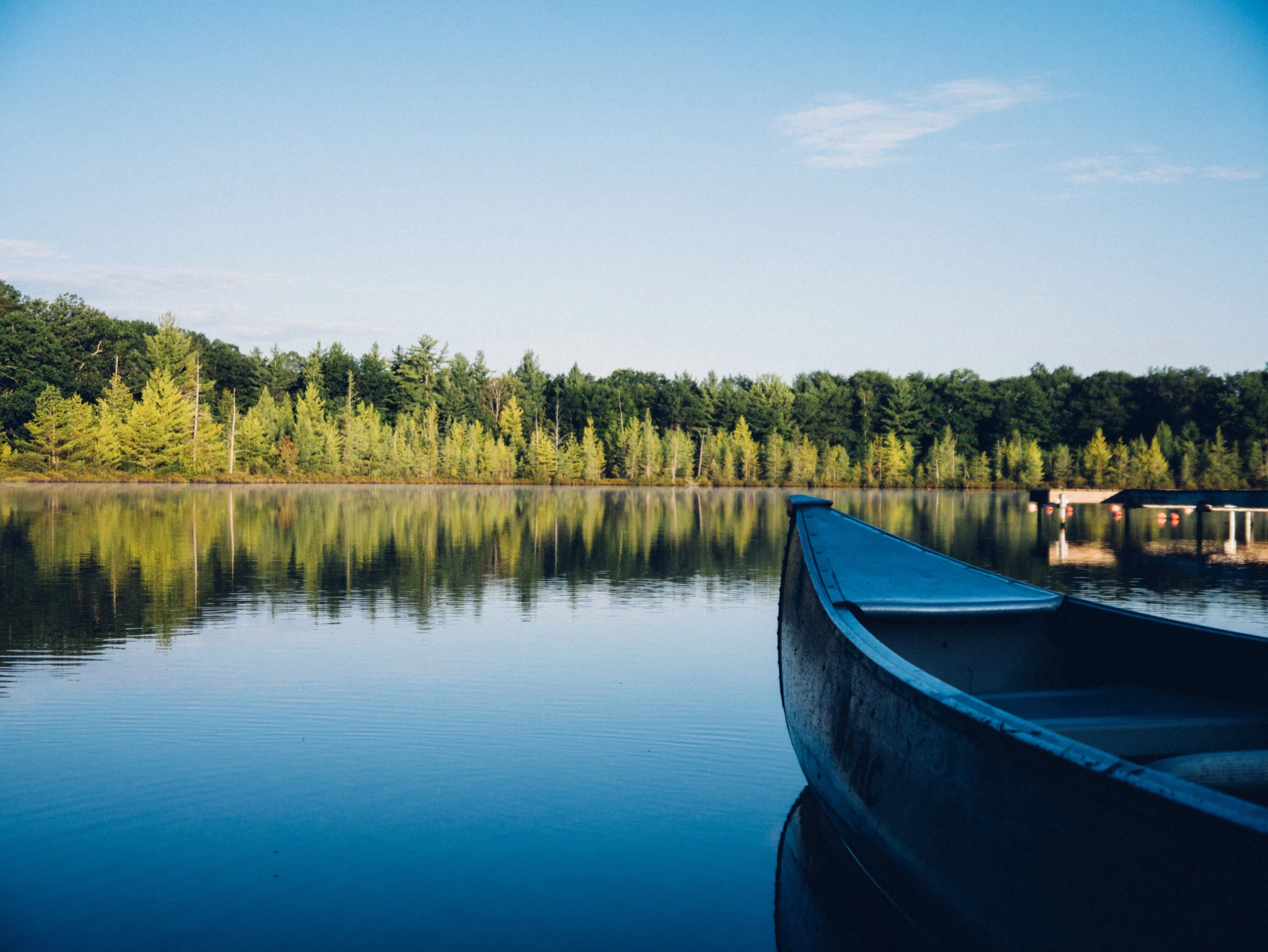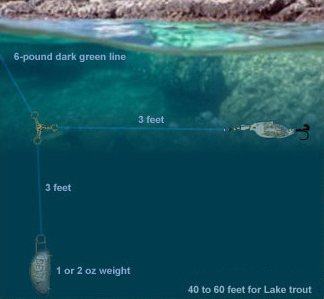
Lake Trout Trolling Techniques & Best Lake Trout Lures
Guests at our resort in Northwestern Ontario are fully rewarded in their pursuit of Northern Pike. Our lakes are well protected from over fishing which means many more opportunities for our guests. If you are looking for a remote Pike fishing experience look no further.
Trolling for Lake Trout
If you don’t want to use light line, Shakespeare makes Ugly Braid in dark green. Their 10 lb test braided line is as thin as 3 lb mono. Braided line has no stretch so it’s harder on your fishing rod.
You need a light action rod with 6 lb test line or 8 lb ultra thin braided line. You also need three-way swivels and a 1 or 2 oz weight depending how deep you want to fish, which depends on what time of year it is.
The 3-way swivel technique below is ten times better then using steel line or bait-walkers and it’s a lot more fun than using down-riggers. All you need is your Walleye stick.
By using light line, the line has less friction with the water and slices through so that your line goes down to the bottom without having lots of line out. Tie two 3 foot pieces of line to your three-way swivel. Use a 1 or 2 oz. weight on one line and a light lure on the other. Lake Trout like small lures more than big lures. The very best lure is a small Sutton Silver Spoon. You can also use #1 or #0 Mepps, Panther Martins, Moose Spoons, tiny DareDevils, Nasty Boyz, or Blue Foxes. Small Cleos or a small Mepps Cyclopes are also good but you have to shorten the lead line because these lures are heavy.
A 1 oz weight with 6 lb test dark green line is good for fishing down to 40 feet. A 2 oz weight is good for fishing down to 65 feet.

Trolling Slowly
You only want to move just fast enough for your lure to work and no faster. If your boat is moving too fast, it will be very hard to find the bottom of the lake. If you are using a boat with a bigger motor and it’s hard to keep slow, try back trolling.
Finding the Bottom
The most important aspect of deep water Trout fishing is letting out line to get to the bottom. DO NOT JUST LET YOUR LINE OUT UNTIL IT HITS BOTTOM. Hold the rod in one hand with the bail open. Let the line run through the palm of your other hand and grip the line. Once the boat starts moving and you have a good straight troll going, open your hand with the line then close it again. This way you can let out a foot or two of line at a time. Get a rhythm going. Open, close, open, close. Your rod tip will bounce up and down as you release little bits of line. The rhythm of your rod tip bouncing will be disrupted when your weight hits the bottom of the lake. When this happens, reel up a foot or two. The purpose of this procedure is to keep your 3-way swivel setup from getting tangled.
Trout are funny when it comes to hitting your lure. Small ones will hit and then take off so you know you have a fish on. The really big Trout will hit the lure and slowly swim away. Some are so big they don’t know they’re hooked. So if you get a snag, make sure it’s not a fish before you start tugging on your line. If it’s a big Trout, loosen the drag on your reel because they will go nuts and strip a 100′ of line off your reel before you can turn them. Keep your drag set for 6lb test line and do not horse the fish in.
Weather
In the summer time, Lake Trout hit best in the morning between first light and 10:30 AM. They will hit better if the surface of the water is dead calm and it’s a clear sky with high pressure. Any other conditions will cause them to slow down. If it’s early spring, the Trout seem to feed in other parts of the day. In some lakes the Trout feed aggressively before dark.
In the spring, the Lake Trout will be right up to the surface. As the water starts to warm up with the changing weather, the Trout start to go deeper. Here is the approximate depth for different times of year. This is not true for all lakes. Some smaller spring-fed lakes will have Trout in shallow water all year.
- Just after ice-out: Between 10 feet and the surface
- Mid spring: About 20 to 30 feet deep
- Late spring: About 30 to 45 feet deep
- Summer: Summer is the tricky part. Many believe that the Lake Trout go to the deepest part of the lake and stay dormant. In actual fact, the Lake Trout stay suspended in 53° thermal layers or concentrate in shallower holes where a natural spring pumps cold water into the lake. Why are they there? That’s where all the baitfish are. There will be Trout deeper than 60′ or on the bottom in the deepest part of the lake but they are not feeding. When they do feed, they come shallower.
Structure and Wind
Take a close look at the structure of the shoreline and try to extend the elevation patterns into the lake. If you see a cliff, odds are the water is deep at its face. If you see a string of islands, odds are there is a shallow shoal that runs between them. Trout like drop-offs so you would want to troll parallel to the string of shoals and not over them.
When you drop your line to the bottom, count how many times you let out line. You can get a good estimate of the depth. For Lake Trout, try to stay in 30-60′ and close to shore. If you come across a spot and catch a Trout, odds are there are more of them there.
The wind is very important when Trout fishing. Traditionally for warm water fish like Walleye or Pike, you would fish on the side of the lake were the wind is blowing. The logic being that the fish follow the surface food that is being blown in. With Trout it’s the exact opposite. The wind also blows the warm surface water, which does not hold enough oxygen for the Trout. Thus fish the side of the lake where the wind is coming from.
There will be Lake Trout out in the middle of the lake suspended about 40-60′ down. They are usually in close proximity to schools of bait-fish. If you are closer to shore in 40-60′ feet’ of water and not catching anything, drop your line down to the bottom so you know how deep you are and then leave your rig at that depth and head out into the open water. In the open water, you will usually catch less Trout but they will be bigger. This is not always true. There are occasions where all the Trout are out in the open water, especially when the last few days have been hot with a strong wind that keeps changing direction.
Depth Finder
It’s good to have a depth finder so you can map the schools of bait-fish that are suspended. When you do come across a school, troll around the outside of the school. The Lake Trout sit right underneath the school waiting for weak or injured fish to venture outside the school. Out in the middle of the lake, you will find these schools of bait-fish in the 30-60′ range. It’s different on most lakes but this is a good place to start.
Middle of Summer Lake Trout
The middle of summer is the time when people spend the least amount of time hunting down Lake Trout. With the 3-way swivel method, the middle of the summer can be the best time because the Lakers are concentrated in the deep holes and not spread out all over the lake like they are in the spring. Once you find a spot in the summer where you are catching Lake Trout, keep going back because they will stay in the same spot the whole summer.
A Lake Trout’s feeding turns on and off like a light-switch. You can find a spot where you are mapping fish on your depth finder and fish that spot for days without catching anything. Then all of a sudden, they start feeding like crazy for an hour or two and then stop dead again. You have to keep trying. Perseverance is a major factor in successful Lake Trout fishing.
Best Lake Trout Lures
Lake Trout Lures for Casting or Trolling Shallow in the Spring
- Little Cleos
- Mepps Cyclops
- Mepp’s Long-Cast
- Spinners
- Dardevle Spoons
- Johnson Silver Minnow
- Krocodiles
- Original Floating Rapalas
- Junior Thundersticks
Weightless Spoons and Spinners for 3-Way Swivel Rigs, Baitwalkers and Downriggers
- Sutton Silver Spoon
- Moose Spoon
- William’s Wabbler
- Noc Flutter Laker Taker
- Blue Fox Vibrax Spinner
- Small Floating Rapalas
- Nasty Boyz
- Lucky Strike Canoe
- Wobblers
- Panther Martins
- Small Mepps Bucktails
Free Trolling Down-Deep Lures
- Rapala Down-Deep Husky Jerks
- Flatfish
Let us help plan your next fishing adventure!
We can accommodate singles, families, or groups with up to 10 people in one cabin.
